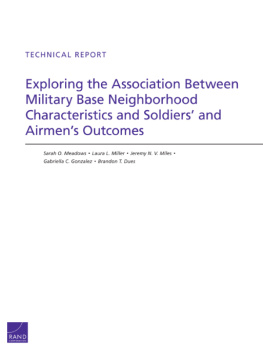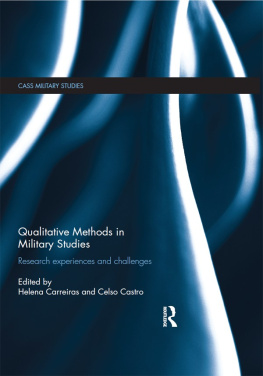TECHNICAL REPORT
Exploring the Association Between
Military Base Neighborhood
Characteristics and Soldiers and
Airmens Outcomes

Sarah O. Meadows Laura L. Miller Jeremy N. V. Miles
Gabriella C. Gonzalez Brandon T. Dues
Approved for public release; distribution unlimited

This report results from the RAND Corporations Investment in People and Ideas program. Support for this program is provided, in part, by donors and by the independent research and development provisions of RANDs contracts for the operation of its U.S. Department of Defense federally funded research and development centers.
Library of Congress Cataloging-in-Publication data is available for this publication.
eISBN: 978-0-8330-7880-3
The RAND Corporation is a nonprofit institution that helps improve policy and decisionmaking through research and analysis. RANDs publications do not necessarily reflect the opinions of its research clients and sponsors.
RAND is a registered trademark.
Copyright 2013 RAND Corporation
Permission is given to duplicate this document for personal use only, as long as it is unaltered and complete. Copies may not be duplicated for commercial purposes. Unauthorized posting of RAND documents to a non-RAND website is prohibited. RAND documents are protected under copyright law. For information on reprint and linking permissions, please visit the RAND permissions page (http://www.rand.org/publications/permissions.html).
Published 2013 by the RAND Corporation
1776 Main Street, P.O. Box 2138, Santa Monica, CA 90407-2138
1200 South Hayes Street, Arlington, VA 22202-5050
4570 Fifth Avenue, Suite 600, Pittsburgh, PA 15213-2665
RAND URL: http://www.rand.org/
To order RAND documents or to obtain additional information, contact
Distribution Services: Telephone: (310) 451-7002;
Fax: (310) 451-6915; Email:
Preface

This report explores the applicability of neighborhood studies theory and social indicators research to our understanding of the quality of life in and around military bases. Preliminary research suggests that a neighborhood studies assessment of military installations and their environs could contribute to military decisionmaking in such areas as programming and distribution of resources across base support services. This exploratory analysis also highlights gaps in neighborhood studies methodology that need to be addressed in future research. Finally, we outline how a more in-depth neighborhood studies analysis of military installations could be conducted.
This report results from the RAND Corporations continuing program of self-initiated independent research. Support for this program is provided, in part, by donors and by the independent research and development provisions of RANDs contracts for the operation of its U.S. Department of Defense federally funded research and development centers.
This research was conducted within the RAND Arroyo Centers Manpower and Training program, with the cooperation of RAND Project AIR FORCEs (PAFs) Manpower, Personnel, and Training Program. RAND Arroyo Center and PAF, both part of the RAND Corporation, are federally funded research and development centers sponsored by the U.S. Army and U.S. Air Force, respectively. Additional information about these centers is available on their websites: http://www.rand.org/ard.html and http://www.rand.org/paf.html.
Figures

Tables

Summary

Current extended military engagements in foreign nations have taken their toll on U.S. service members and their families. As a result, the services have made renewed commitments to support the needs of the families of military personnel. Quality of life and family programs across the services continue to grow, including recent efforts designed both to support service members and their families across the deployment cycle and to instill resiliency even before they face a deployment. For example, both the Army and the Air Force have adopted community covenants (Donley, 2009; U.S. Army OneSource, undated). Community covenants are designed to develop and foster partnerships between states, communities, and bases in order to improve the quality of life of service members and their families. These covenants reaffirm the services commitment to family and community well-being and recognize that the success of an all-volunteer force depends on the satisfaction, health, and well-being of service members and their families. The services generally rely on surveys, focus groups, service utilization reports, and analysis of recruitment and retention reports to assess service member and family satisfaction with programs and services and, ultimately, family well-being. To our knowledge, none has applied neighborhood studies theory and methods to better understand these military issues.
Neighborhood studies, a well-established field within sociology, assess the association between social and economic characteristics of neighborhoods, demographic characteristics of residents, and indicators of health and well-being. Generally, neighborhoods characterized by high socioeconomic status, that are safe and free of crime, and that offer recreational activities are associated with better mental and physical health among residents. Empirical studies of the neighborhood-health link have demonstrated that the impact of neighborhood characteristics exists regardless of an individuals own characteristics, such as age, race, ethnicity, or gender. Theoretically, neighborhoods are linked to well-being because higher-quality neighborhoods offer more resources and better infrastructure, facilitate social relationships, and contribute little in the way of additional exposure to stress for residents.
Despite the growing body of evidence supporting a link between neighborhood and health and well-being, none of the existing research has examined this association specifically for a military population. Studies of military satisfaction and retention and spouse satisfaction with military service have considered the role of particular characteristics, such as the recreational facilities, the local labor market, and the quality and availability of child care. But the relative quality of military installations and their surrounding neighborhoods may also be of importance for service member and family health and well-being. Installations, and the communities where they are located, vary in terms of the quality of life they provide inhabitants (e.g., spouse employment opportunities, family programs, child care, recreational facilities). Similarly, the families who live in these communities and who are assigned to these installations also vary in terms of their needs. Given that neighborhood context and family needs vary, a one-size-fits-all approach to base resource allocation and the provision of services, without acknowledging that certain challenges and resources may be geographically dependent, may not be the most effective in fostering health and well-being among service members and their families. Thus, the services may want to use this approach as part of their efforts to identify gaps in support to service members and families so that they can make the necessary adjustments and better compensate where communities are lacking.















